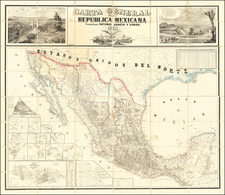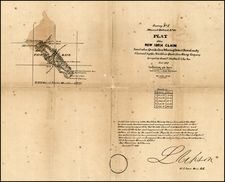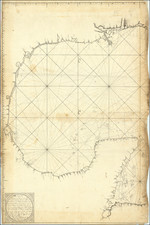Rare Late State of Brue's Monumental Wall Map of Texas, Upper California & Mexico
Rare late state Adrien-Hubert Brue's wall map of Texas, Upper California and Mexico, one of the most interesting large format maps of the region published during the period.
Brue's wall map is a tour de force for the Transmississippi West, coming on the eve of the Mexican War, California Gold Rush and the period of intensive American exploration in the west. Wheat described Brue's work as monumental, much on the order of the Arrowsmith and Wyld maps of the period. First issued in 1834, the map was revised in 1837, 1839, 1840, 1845 and 1848, keeping abreast of the changing landscape of the region and the political intrigues of the United States, England, France, Russia and of course Mexico. Brue's map apparently revised a final time in 18855 and was thereafter acquired an re-issued in later editions by Alexander Vuilleimin, beginning about 1856. The present example includes a seal that it was acquired in 1856, likely referencing the date the plate was transferred by Brue to Vuillemin.
The early states of the map contain one of the earliest obtainable depictions of the route of Jedidiah Smith. The Route de Smith in 1826 connects Lac Teguayo, to the R. Adams, Rock Salt Cavern and Seeds-Keeder River and San Diego and then extends north to M. St. Joseph. The information was derived from a letter from Smith published in the Nouvelles Annales des Voyages in 1828. Wheat notes that the Brue's attempt to actually depict Smith' route without Smith's map was a shot in the dark, but nevertheless makes Brue's map "one of the foundation stones of western mapping history…."
The present example reflects the changes made after 1848. The map now reflects American acquisitions of Texas, New Mexico and Upper California, with a modern configuration for the state of California and Territorial depictions of Utah and New Mexico incorporating the areas that would become Arizona, Nevada, and part of Colorado. The cartographic features of the Great Basin are dominated by Fremont's expeditions, with California reflecting updated information from immediately after the Gold Rush.
Curiously, the map does not adopt the changes to the US-Mexico Border enacted by the Gadsden Purchase, nor does it reflect the new Territorial borders for Nevada, Arizona, Utah, New Mexico and Colorado, all of which established by 1861.
The most profound changes appear in California. The mountains and hydrographical details have evolved significantly. The changes begin south of the Smith River and included the addition of the Coastal Range and the Sierra Nevada Mountains, as well as the addition of both the Sacramento River and its tributaries in the North and the San Joaquin River and its tributaries in Central California. The mythical rivers flowing from Utah are now gone, and Tule Lake has been significantly reduced in size.
Further south, the course of the Colorado River has been corrected, although its connection to the R.S. Clara (Virgin River) is shown with a dashed line, suggesting the region was still not well explored. The Rio Martires is now the Mohave River, with a partially charted course. The border between California and Baja California has also been corrected.
In Arizona, the course of the Gila is unchanged, but the River system flowing from the north is signficantly improved.
Rarity
The late editions of this map are quite rare. This is the first example we have offered for sale.
Andre Hubert Brué was a French geographer and cartographer. Born in Paris, he served in the French Navy, joining the Baudin expedition to the Pacific (1800-1804). After his sea service, Brué applied his navigation and charting skills to creating finely-crafted maps, which were renowned for their crisp engraving and accuracy. He drew directly on the copper of the plate, creating what he called encyprotypes. He is best known for the Atlas universal de géographie physique, politique, ancienne et moderne.

![Nouvelle Carte Du Mexique, Du Texas Et D'Une Partie Des Etats Limitrophes . . . 1840 [Proposed Railroads In Texas -- First Appearance of Arizona on a Printed Map] By Adrien-Hubert Brué](https://storage.googleapis.com/raremaps/img/small/103480.jpg)










![(Mexican-Aztec Paintings) Facsimile, page 19 of an original [Mex]ican painting of Sir Thomas Bodley's collection [in the Bod]leian Library, Oxford, [Aglio's] Antiquities, vol. 1](https://storage.googleapis.com/raremaps/img/small/102328.jpg)

![[ Texas-Mexico Border Treaty ] Que á efecto de facilitar el cumplimienio [i.e. cumplimiento] del art. 3. del Tratado de limites entre estos Estados y los Unidos del Norte América ... Habiéndose concluido y firmado en la Ciudad de México á los 12 dias del mes de Enero de 1828, un tratado entre los Estados-Unidos Mexicanos y los Estados-Unidos de América [A Treaty having been concluded and signed in the City of Mexico on the 12 day of January 1828 between the United States of America and the Mexican United States for the purpose of establishing the true dividing line and boundary between the two nations]](https://storage.googleapis.com/raremaps/img/small/100806.jpg)

![[Matagorda Bay] Bahia De S. Bernardo](https://storage.googleapis.com/raremaps/img/small/58540.jpg)
